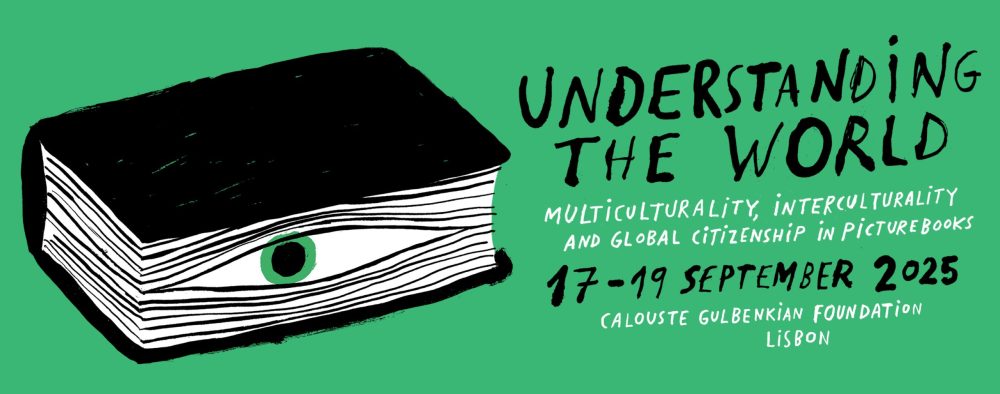10th European Network of Picturebook Research Conference
Understanding the world: Multiculturality, interculturality and global citizenship in picturebooks
17 – 19 September 2025
Organising Committee:
Sandie Mourão (CETAPS, Nova University Lisbon)
Ana Margarida Ramos and Inês Costa (CLLC, University of Aveiro)
In collaboration with:
Fundação Calouste Gulbenkian, Lisbon
With support from :
Direção-Geral do Livro, dos Arquivos e das Bibliotecas (DGLAB), Biblioteca Nacional, and Plano Nacional de Leitura (PNL)
Our conference illustrator is André Letria
The oft cited and resonating metaphor of books acting as ‘windows, glass sliding doors and mirrors’ by Rudine Sims Bishop (1990, p. ix) is now over 30 years old. It has had a huge impact on the world of children’s literature and what has become known as ‘multicultural literature’ (Short et al, 2016), ‘transnational literature’ (Arizpe, 2021) or ‘global literature’ – that which according to Hadaway and McKenna (2007) facilitates ‘reading across the boundaries of culture, race, ethnicity, language, religion, social and economic status, sexual orientation, and physical and intellectual ability’ (p. 9–10).
Literature has long been recognized as an intercultural catalyst and picturebooks are acknowledged for their potential to promote intercultural learning (cf. Botelho & Rudman 2009; Dolan 2014; Mourão, 2023; Roche, 2015; Short et al., 2016). The concept of interculturality is defined by UNESCO as ‘the existence and equitable interaction of diverse cultures and the possibility of generating shared cultural expressions through dialogue and mutual respect’ (2006, p. 17). Literature can facilitate reading across boundaries, offering readers a view of the world they might otherwise never experience. Or it can disrupt this reading, challenge linear interpretations, and recognize the fractures and distortions that lead to new becomings (García-González et al., 2020). Such literature can empower readers to value cultural diversity, respect difference, and consider a set of universal values that include human dignity, human rights, democracy, justice, fairness, and equality (Council of Europe, 2018; Radar, 2018)
Global citizenship has become increasingly dominant in international discourse. It is defined by the United Nations as an ‘umbrella term for social, political, environmental, and economic actions of globally minded individuals and communities on a worldwide scale’. Global citizenship overlaps with the concept of interculturality through its focus on universal values and respect for difference but goes further in its commitment to social justice with an emphasis on civic responsibility. Children’s literature has a role to play in fostering civic responsibility, especially in a world where increasingly, local and global issues associated with climate change, sustainability and insurmountable human rights and refugee crises, often culminate in an increase in racism, marginalization and fear (Leland et al. 2013; Short, 2011).
This 10th European Network of Picturebook Research Conference wishes to disentangle how picturebooks employ their multimodality – the pictures, words, design and materiality – to become the veritable vehicles for understanding the world. The big question is ‘How do they act as mediators?’.
References
Arizpe, E. (2021). Transnational. In P. Nel, L. Paul, & N. Christensen (Eds.), Keywords for children’s literature (2nd Edn.), (pp. 187-90). New York University Press.
Botelho, M.J. & Rudman, M.K. (2009). Critical multicultural analysis of children’s literature: Mirrors, windows, and doors. Routledge.
Council of Europe (2018). Reference framework of competences for democratic culture, (Volume 1). Council of Europe.
Dolan, A. M. (2014). You, me and diversity. Picturebooks for teaching development and intercultural education. Institute of Education Press.
García-González, M., Veliz, S. & Matus, C. (2020). Think difference differently? Knowing/becoming/doing with picturebooks. Pedagogy, Culture & Society, 28(4), 543-562, DOI: 10.1080/14681366.2019.1667858
Hadaway, N. L. & McKenna, M. J. (2007). Breaking boundaries with global literature. celebrating diversity in K-12 classrooms. International Reading Association.
Leland, C., Lewison, M., & Harste, J. (2013). Teaching children’s literature. It’s Critical! Routledge.
Mourão, S. (2023). The effectiveness of picturebooks for intercultural awareness in foreign language education: A scoping study. Zeitschrift für Interkulturellen Fremdsprachenunterricht, 28(1), 173-209.DOI: https://doi.org/10.48694/zif.3620
Rader, D. (2018). Teaching and learning for intercultural understanding. Engaging young hearts and minds. Routledge.
Roche, M. (2015). Developing children’s critical thinking through picturebooks. A guide for primary and early years students and teachers. Routledge.
Short, K. (2011). Children taking action within global enquiries, The Dragon Lode, 29(2), 50-59.
Short, K., Day, D. & Schroeder, J. (2016). Teaching globally. Reading the world through literature. Stenhouse Publishers.
Sims Bishop, R. (1990). Mirrors, windows, and sliding glass doors. Perspectives, 1(3), ix–xi.
UNESCO, (2006) UNESCO guidelines on intercultural education. UNESCO.
